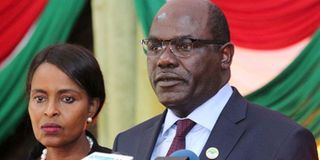How IEBC tried to avoid another Supreme Court shock

IEBC Chairman Wafula Chebukati and his deputy Consolata Maina. Raila Odinga has disputed voter turnout in October 26 repeat poll. PHOTO | FILE | NATION MEDIA GROUP
What you need to know:
The commission’s emphasis on having all the forms was evident when former South African President Thabo Mbeki visited the auditorium and was taken through the verification process at one of the tables.
Even he was surprised that the officers had sent away the Molo Constituency Returning Officer when they found that one of the original Form 34A was missing and he had only brought a photocopy.
With indications that non-governmental organisations could challenge the way the October 26 repeat election was conducted at the Supreme Court, the electoral commission appeared not to be taking any chances.
The results declared by the Independent Electoral and Boundaries Commission (IEBC) at the Bomas of Kenya Monday were based on the verified physical forms filled by election officials at the polling stations and constituency tallying centres.
CHEBUKATI
That verification was done at tables on the floor of the auditorium starting Friday, when the commission began receiving Forms 34A and 34B brought to the National Tallying Centre by constituency returning officers.
Asked on Sunday evening whether he had changed his position from 12 days ago, when he said he could not guarantee a credible election, IEBC chairman Wafula Chebukati was optimistic.
“We are here because of the Supreme Court judgement that directed us to hold a fresh presidential election. On the Eighth of August, the commission thought we had done the best election ever, but here we are now,” he said.
He suggested that the commission had set aside its divisions in the wake of the annulment of the August 8 election, saying that they were all satisfied that the process was done properly, in a free and fair environment.
FORMS
“I expressed my concerns on the process, I had my questions and most of the concerns I expressed were answered and as chairman, I can confidently stand here and tell you that the process that we are now carrying on is above board and except for the areas which did not vote, I can confidently say that I am satisfied with this process and that we shall give the people who voted, the Kenyans who voted, the will of those people will be realised in these ballots which we are counting here,” he said.
Mr Chebukati has been emphatic that the basis on which the results would be announced is the physical delivery of the forms delivered by the returning officers.
“We have nothing to hide and Kenyans will have to know, and in any case you have the public portal, where you are accessing that information. I see the media are also tabulating their own figures. Let us all do it and compare notes at the end of the day,” he added.
MOLO
The commission’s emphasis on having all the forms was evident when former South African President Thabo Mbeki visited the auditorium and was taken through the verification process at one of the tables.
Even he was surprised that the officers had sent away the Molo Constituency Returning Officer when they found that one of the original Form 34A was missing and he had only brought a photocopy.
The poll official had to do a six-hour round trip by road, going to Molo, finding the form he had forgotten in a photocopy machine and then having to bring it back to Nairobi to get clearance.
The availability of the original Forms 34B and 34A – with security features— would work in the commission’s favour if a physical scrutiny is ordered.
SERVER
Insiders at the commission believe that the Supreme Court annulled the election mostly because the electoral agency was unable to explain itself.
This inability was evident when its lawyers were asked about the place of ballot papers put in the wrong box, the lack of security features on some of the result forms scrutinised and especially on the access to the servers.
The commission’s explanation that there was live access to the servers more than two hours to the deadline set by the Supreme Court was lost in the report by the experts appointed by the court to work with the registrar, Esther Nyaiyaki.
If the matter comes up and the commission is ordered to “open up” its servers, this will one of the areas of significant concern.
25 AREAS
Tied to this would be the question of the actual number of people who voted given that most voters were identified using the Kenya Integrated Election Management System (Kiems) kits and some manually, checking their details against the voters’ register for every station.
Among the issues that could be brought up at the Supreme Court would be the failure to hold elections in 25 constituencies.
On Monday, vice chairman Consolata Maina said the decision not to hold the elections in the constituencies had been made accordance to the Elections Act, which provides for the winner to be declared if the areas where the election has not been held would not make a difference.





